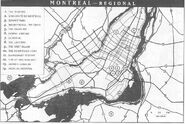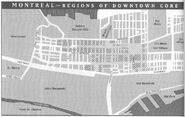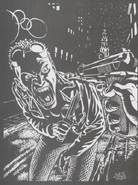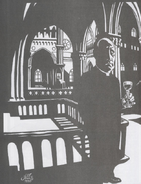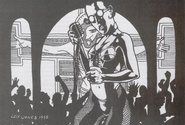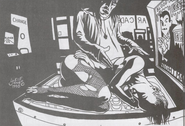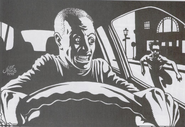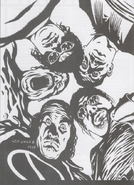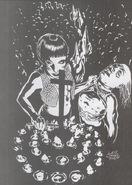Montréal, called the "City of One Thousand Steeples" by its inhabitants, is the second-largest city in all of Canada and the largest city in the province of Québec.
Gothic-Punk Montréal is a city of subtle and unmistakable dread, where abandoned buildings and run-down churches cower in the shadows of skyscrapers. While not as violent as a city like Detroit, for example, its corruption runs deeper, working behind closed doors.
Media[]
CBMT (CBC)
CFCF (CTV)
CIVM (Tele Quebec)
CJNT (CH)
Vampire: The Masquerade[]
| “ | Welcome to Montreal, City of Black Miracles and unhallowed shrine of our most glorious Sabbat. Yes, we're so glad you came, n'est ce pas? Walk our catacombs in search of blasphemous knowledge, enjoy all manner of titillating diversions with our deliciously putrescent "Toy". And forget that language-barrier nonsense; we'd be delighted to hear you scream for mercy in English or French. | ” |
Montréal is one of the spiritual centers of the Sabbat, often called the "City of Black Miracles" by the local Cainites. It has often been said that while Mexico City is the "heart" of the Sabbat, Montréal is its "soul".[1] Whereas other Sabbat dioceses in North America attract the downtrodden and the bloodthirsty, Montréal is home to several Covens that study the Paths of Enlightenment and advance the Sabbat's spiritual understanding.[2] Montreal is often referred to as the "hammer" to the "anvil" of Detroit.[3]
Montréal is a city of enigmas, an onion of almost infinite layers, if you will. Peel away one skin and several more await, seductive in what they hide. It has received the name "City of Black Miracles" because of the dark faith of its nocturnal inhabitants. Those who live within its island confines, whether mortal or immortal, feel as some terrible force looms just beyond the senses.
Montréal is also a city of contrasts, where modern skyscraper towers over old churches and cathedrals. The new and the old world clash, not only for mortals, but for the undead. Mention of the Sabbat conjures images of the crime infested streets of New York, the despair-gripped population of Detroit, the black heart of Mexico City, and the moral debauchery of Amsterdam. These modern interpretations of the Sabbat apply to Montréal, but the Cainites also make Montréal a city of knowledge and faith.
New York and Mexico City attract the bloodthirsty, Detroit appeals to the downtrodden, Amsterdam lures the abusive and Montreal draws the scholarly and educated among the Sabbat.
History[]
Although the city is one of the world's most modern, its past defines it. Most of the buildings were built in the 19th century – or even earlier – and, to this day, cast their long shadows from the past into the present.
First discovered in 1535 by Jacques Cartier, the "Mount Royale" who gave the city its current name became a colony for Catholic missionaries from France some 70 years later, which was called Ville-Marie. On Cartier's ship was a Gangrel antitribu named Louis Drapeau, who became a sort of leader and liaison for French Sabbat who sought relief from Camarilla oppression in the New World. Using Catholic missionaries as a major source of food, the Sabbat encouraged the nascent settlement of Ville-Marie to grow and thrive. By that time, Louis became the ductus of the first coven of the Montréal region, Les Acadiens ("The Acadians") - who, unchecked, acted on their predatory whims skinning the Iroquois natives while feeding on their children.
It did not take too long and Louis himself was destroyed after natives attacked the village, knowing that the monsters lurked within it. The only major Sabbat left in the city was a Tzimisce named Connaught and his Bratovitch attendants. Connaught used Koldunic Sorcery to keep himself safe, but found the overwhelming surges of Faith in Montreal harmful to his spells. Nevertheless, Les Acadiens reformed, with Connaught as the leader sometime later, but instead of oppose the natives, from that point the Sabbat egged them and used their attacks as a cover for their own depredations on the colony's populace. The white man struck back at the Iroquois, but it had been the Sabbat who had came in the night to attack the residents of Ville-Marie.
These attacks became too severe, and the Camarilla in France stepped up military dominance of the colony, and during the attacks of the Iroquois, a regimen of French military took over the country. They really did it in the name of the Camarilla, and the Sabbat was temporarily pushed back. By 1660 nearly 20 Cainites had been killed and there was no sign of peace - it was by that time that the Liber Defuctorum was created as a list of those Sabbat who died valiantly - the list itself would eventually become what is currently known as the Litany of Blood.[4] Though the Camarilla officially took over Montréal, the Sabbat was now two packs strong, Les Acadiens and Les Capots-Bleus. These marauding packs continued to attack disguised as Natives, spreading rumours of Iroquois and Huron viciousness. Soon, two more packs soon joined their ranks: Les Miserables and the Shepherds of Caine.
Knowing they were mere figureheads for their more powerful Elders in Paris, many of the Camarilla officials withdrew into debauchery and fled when the opportunity arose during the Seven Years War, allowing the Sabbat to regain their foothold.[4] As Montréal became a British colony after the Treaty of Paris, the Ventrue noticed the city, sending one of their own – the Scot Kyle Strathcona – to act as Prince.[4] Strathcona, still nursing resentment against the Camarilla due to Ventrue involvement in the British Empire, defected in secret to the Sabbat in 1776, after most Camarilla members had already abandoned the domain during the American Revolution.[4] The remaining Camarilla had been converted to the Sabbat or were executed after the primogen tried to depose Strathcona in the events of the Rebellions of 1837.
Any other Camarilla in the city quickly became enticed with the brothel maintained by another pack, the Widows. Using French uprising against the British as cover, Strathcona uprooted what was left of his former sect, and the Sabbat proclaimed full control over Montréal once again. Those lands continued to play an important role within the Second Sabbat Civil War when, during the Eucharist Congress of 1910 (one of the greatest meetings of religious minded individuals in the world), the Shepherds of Caine and the pack of the Librarians staged an event that came to be known as the "Conference of Caine". Under an unspoken treaty of non-violence for the first time the conference is best remembered as the catalyst that put an end to the Sabbat Civil War.[5]
Despite their celebrations, the Sabbat knew Montréal did not completely belong to them. The Shepherds warned all the residents that demons lurked within the City of Black Miracles, and the Mount Royale was seen as a locus of that dark energy. No Creation Rites ever succeeded on the mountain, shovelheads were sometimes seen being pulled back into their graves as they had finally pulled their way out of the ground. The tunnel underneath the mountain had caused the disappearance of no less than six Sabbat, and are generally thought as "off limits". The Shepherds helped form the Sabbat Inquisition to find those who worshipped the dark creatures in Montréal, and they regularly found small infernalist cells, but they have always suspected there were many more out there. Cedilia the Tongue, a Malkavian from the Les Miserables pack was found guilty of infernalism, and it is said that though her Dark Thaumaturgy she was powerful enough to turn vampires into black trees, but even that witch was taken down eventually.
Soon after World War I, Strathcona was elevated to the rank of Cardinal of Canada, leaving the archbishopric of Montréal for the only surviving Widow after the fire that destroyed the pack's brothel in 1911 - she was a Toreador antitribu known as Véronique La Cruelle, a cruel Cainite indeed.[5] Véronique’s tenure saw the rise of conflict with the Camarilla through Prince Jonah of Ottawa (culminating in an event known as the "October Crisis"), as well as the incursion of Followers of Set from Haiti. Using mortal uprisings (like the Front de libération du Québec) as smokescreens, the new Archbishop let her enemies believe that the Sabbat was behind it, striking against them in a surprise attack,[5] and to this night the Sabbat has yet to be pushed back by the Camarilla.
However, the Serpents proved much more difficult to fight, for they wormed themselves into the structure of the city, and it became hard to cleanse it of their presence. The Setites flooded into the city merged with Haitian immigrants in the 1970s, and the Shepherd's pack began to find their blood cults seemingly everywhere, seeing them as a threat both politically and religiously. The Followers of Set had to be rooted out and destroyed at all costs. It was then that Sangris, a Haitian Serpent of the Light, came to lead the a full-out war against his hated father-clan. He organized Snake-hunts, had important politicians Dominated for the Sabbat before the Setites could get to them, and used his powerful magic to quell the voudun employed by the Followers of Set. After their initial victories, Véronique even used Vicissitude to turn one of the Setite leaders named Moise into a leather jacket, and was never seen without it again.
Then Sangris appealed for the help of the powerful demon Metathiax, and with the creature's assistance he poisoned a citywide Blood Feast traditionally held by the Sabbat on the Twelfth Night of the year. Being a secret infernalist, Sangris used his demonic powers to implicate the Setites in the corruption of Sabbat’s rites as everyone who took part on the celebration passed out mysteriously, except for Sangris himself, Pierre Bellemare, Elias the Whale, and the nomadic Road Wolves (which arrived late). Sangris declared the Setites responsible for the treachery and tracked the mysterious diseased pawns back to a major Setite temple.[6] He sent the Road Wolves to attack the Temple head-on in one big fiery battle, and while the Wolves and the last Setites of the city destroyed themselves, the rest of the Sabbat had reawakened - though many had mysteriously disappeared. Véronique La Cruelle was one of them, and in the vacuum of power that followed that battle, Sangris became the new Archbishop of Montréal. Those who had a chance to oppose him for some reason suffered from lingering effects of the poisoned blood they had consumed.[6]
Sangris ruled for 20-some glorious years with the Shepherds' support, leading multiple strikes against the Ottawan Camarilla to keep the more violent packs busy, leaving the intellectual packs to ponder over their work in peace. He pushed back Camarilla control in Québec City, and carefully avoided what could have been a war with the Lupines during the Oka Crisis. In 1992, evidence of his corruption was uncovered by the Sabbat Inquisition, as two Inquisitors investigated evidences of Sangris the Serpent's infernalism. A tribunal was called by Santiago DeSoto, former Montréal resident and now Judge-Inquisitor, and a three month long trial ensued. Though many stood up for the Serpent, he flatly admitted his guilt and on August 15, Sangris was executed via thaumaturgical fire by Santiago deSoto. The Inquisitor retired soon after, and went back to his childe's pack, The Navigators, for a life on the water.[7]
In the aftermath, Strathcona himself had to intervene, installing the Lasombra Carolina Valez of the Lost Angels pack from L.A. as an interim Archbishop in 1995, until the city could calm the fuck down.[8] Barely two years had passed and her rule was already being challenged by Alfred Benezri of the Shepherds of Caine, one of the most prestigious covens of the city, and Ezekiel, the childe of Sangris and leader of a Black Hand pack known as 25:17.[9]
After the disaster of Sangris, the Inquisition kept tabs on the city. When two of its members had vanished in 1993, the Grand Inquisitor sent two of her best agents, the Knight-Inquisitors Mercy and Kervos, to the city.[10] In 1997, Mercy uncovered the existence of the infernal coven of Pierre Bellemare. Launching numerous raids, the Inquisition imprisoned and tortured dozens of vampires. Bellemare was able to flee, only further aggravating Mercy’s rampage. Carolina Valez was unable to reign her in, until she was approached by one of the vanished Inquisitors, Cairo, who had been corrupted by Bellemare and been temporarily freed from his grip. Promising to deliver Bellemare in exchange for her unlife, Cairo led Valez and the Inquisition against the secret hideout of Bellemare’s pack, but the infernalist himself was nowhere found.[10]
Mercy now turned against Valez and Cairo, charging both with infernalism. Valez, completely taken by surprise, turned to Benezri to save her, promising him to abdicate from her position. Benezri argued before the inquisitorial trial, winning Valez' innocence. Only a week later, Benezri became Archbishop, while Valez' pack dissolved and she became the Abbot of the Temple of Eternal Whispers.[10]
In modern nights, the city is home to at least eleven permanent Covens, most with their own unique ritae, and several nomadic packs. The central structure is the Temple of Eternal Whispers, who acts as the communal Haven for all Sabbat packs of the city. While most Sabbat are part of pack, several newcomers are not. One example is the Lazarene Agaitas, who aspires to become the new keeper of the Litany of Blood.[10] Since the time of Archbishop La Cruelle, Sabbat take pride in the “Feeding” often draining their victims in artistic or imaginative ways. As a home to one of the sects' three Black Cathedrals, scholars of the Paths of Enlightenment frequent Montréal to compare their studies with their peers. This gives Montréal great influence within the sect, an influence that grows since the Consistory in Mexico City gets weaker over infightings.[1] One of the local packs, the Widows, have begun to steer their interpretation of the Path of Cathari away from the tenets of the Road of Sin espoused by the Elders and focus more on Gnosticism, believing themselves to be God’s caretakers of the material world.[11] Their new interpretation has led to a new influx of packs that seek tutorship from the Widows.
Benezri’s authority was at first strengthened to the degree that he was able to declare the city open for non-Sabbat Noddists in order to commemorate the discovery of a new fragment of the Book of Nod.[10] The events during this event resulted in the fragmentation of the venerable Librarian coven after another accusation by the Inquisition for dealing with a D'habi and a tarnish on Benezri's authority, strengthening the position of his rival Ezekiel.[12] The Inquisition maintains a strong presence in the city, watching for any further signs of infernalism and corruption among the local Cainites. There have also been undertakings of excavating the lore of the vanished Tremere antitribu in St. Laurent.[13]
Geography[]
Montréal is an island city located on the Saint Lawrence River and is home to just over three million people (although only about one million live in the island itself). It is also the second largest french-speaking city in the world. The city's shores are home to the largest inland ports in the world, and Montréal is a port of call for many Canadian and American vessels.
The climate is characterized by long winters which typically last from December to April. Temperatures vary from 32º to -40ºF, making Cainites susceptible to freezing if they stay outdoors for extended periods of time. In summer, temperatures can climb as high as 90º - 110º. In the winter the sun sets approximately 4 P.M. and rises around 7 A.M., and during summer, it sets well after 9 P.M. and rises around 5 A.M.
- Temple of Eternal Whispers - The Communal Haven of the Montréal Sabbat. It was originally built as a small necropolis inside the cemetery, but today the area around and above the communal haven became a park called Dorchester Square.
- Lachine Canal - Although the Lachine Canal once served as the gateway between Great Lakes and the rest of the world, it has fallen into disuse since the Saint Lawrence Seaway opened in 1959. Today, the canal is dotted with abandoned and crumbling factories and docks. The structures are used by homeless and runaways who seek shelter from the elements, their parents, or even their pasts. The Sabbat usually raid these factories when “stocking up” for blood feasts.
- The Underground City - Covering 30 kilometers, right under the downtown core, there is a network of tunnels, malls, metro stations and government offices known as The Underground City. By day it is safe, but by night it becomes the domain of the Sabbat. Poorly patrolled and gloomy, the Sabbat finds it the perfect place for feeding on confused shoppers and playing Games of Instinct. Some Sabbat keep secondary havens in closed-for-the-night malls.
- Saint James United Church - A long-run-down cathedral in the downtown core. The only people who wanted to buy it would destroy it, so it was left to rot and became a haven for the homeless to sleep and the prostitutes to ply their trade. For 8 years now, the Sabbat has used the church's basement to dispose of the remains of blood-feast victims. To date, the pieces of over 500 corpses lie in the darkness, in various states of decomposition, including a number of staked Cainites who failed their Creation Rites. Surrounded by rotting bodies, these vampires have slowly lost their sanity. On rare occasions, a bloodcurdling scream can be heard from the bowels of the church. A few homeless mortals, desperate and hungry, have resorted to eating the decaying corpses, which as resulted in the spread of infectious diseases. The Sabbat just thinks it is funny how stupid mortals really are.
- Angel's Fall - Sheltered by a 12-foot high wall and thick trees is the abandoned mansion of Ravenscrag, which once served as a mental hospital during the 1950s. The home was vacant until 25:17 moved in, and Ezekiel opened a club called Angel’s Fall. The club's dark, brooding atmosphere and location makes it a hit among Sabbat, especially members of the young packs. Angel's Fall is open to both mortals and Cainites, though many mortals do not survive the night. The mansion's ballroom became the main dancefloor, and the wooden floor originally built was overlaid with gray linoleum for the asylum, stained from years of use. Secret passages lead to the house chapel that serves as the pack’s communal haven as well as a dumping ground for past inmates and recent victims.
- The Heart - Very few know of the small secluded fetish club called The Heart. Those who do are members of Montréal's fetish and S&M elite. It is also a common hangout for average Sabbat, and it is the communal haven of The Widows. The Heart is located in the red light district of Montréal, and its discreet entrance is marked by small red leather door that seems to pulse in sync with the music inside. Catering to those who live on the wild side, the club is a labyrinth of corridors and small rooms when patrons engage in any number of activities, including the dancing, heated discussions, art shows, photo shoots, and of course, sexual acts. At The Heart, anything is possible for the right price. Everything is made of red leather, and the lighting is soft red. The inner sanctum of the heart, where the Widows reside, are marked by two double-doors with human bodies, one male, one female, fleshcrafted into place. The room inside is shaped like a seven pointed star, with each corner a small shrine to one of the Seven Deadly Sins. The Rose and Creamy Jade consider the fleshcrafted works of living art forever acting out a sin their greatest works of art. In the center lies a pool of blood that feeds the living walls and statues.
- Heaven - The biggest gay club right now in Montréal, it serves as the lair for the Queens of Mercy Coven. Its three floors are all beautifully decorated in a celestial motif, with hanging dance floors that resemble huge clouds. Heaven’s funky atmosphere and cutting edge music attracts Montréal's hip homosexuals.
- Notre-Dame Basilica - One of the original and most famous of Montréal's churches, it has been a bane to the Sabbat for decades. The church’s aura of faith is simply too great to overcome, and no vampire has ever set foot in it, not even a Shepherd.
- Mount Royal - At the center of the island is the mountain for which the city is named. Mount Royal’s old thick trees and secluded paths contrast with the nearby downtown core. Though it is a tourist attraction during the day, most people avoid it during the night. The twisted gnarled trees block out moonlight, and an eerie silence pervades the place. The Sabbat rarely go near the mountain, since so many Cainites have been lost travelling through it, never to be seen again. Though there’s no rule saying you cannot go near, very few Sabbat ever do, and no Creation Rites are performed if you want them to succeed on the Mountain.
- The Cross - Montréal's skyline is overlooked by a massive lit cross, an illuminated testament to the religious foundation of the city. The original crucifix was placed on Mount Royal on Epiphany (January 6th) of 1612 by Paul de Chomedey de Maisonneuve. It was finally replaced in 1642, and on 1924 a steel cross with electric lights was placed on the site. Though the old cross radiated powerful faith, the new cross is not dangerous and all, and many Sabbat use it as an overlook point of the whole city.
Maps[]
Sabbat Covens[]
The coven is a Sabbat member's family, home, circle of friends and parents all rolled into one. While individual vampires have their own feelings about the conditions in Montréal, their covens have factionalized based on the three vampires who are vying for power: Archbishop Carolina Valez, Alfred Benezri and Ezekiel. The most prominent packs currently active in the city include:
- The Lost Angels - pack of former Archbishop, Carolina Valez. The pack is originally from Mexico, and all of the surviving pack members who have been in existence for over twenty years were active in Los Angeles. Known members: Carolina Valez, Tobias Smith, Gharston Roland, Marie-Helene Dutoit.
- The Widows - a prominent coven in the city, and the most devout Catharists of the Sabbat. Led by The Rose, the Widows share control of the sex industry in Montréal, primarily the S&M/bondage aspect. Known members: The Rose, Creamy Jade, Black Lotus.
- 25:17 - a Black Hand coven led by Ezekiel. Before Sangris’ trial, 25:17 was nomadic and was very active in New York City and Chicago. All of the members have always been Black Hand members in good standing. Known members: Ezekiel, Soldat, Reza Fatir, Yasmin the Black.
- The Shepherds of Caine - one of the oldest Sabbat covens in the western hemisphere, and the oldest coven in North America. Led by Alfred Benezri, the Shepherds were instrumental in the creation of the Sabbat Inquisition, and the senior coven members are the founders of the philosophy of Nocturnal Redemption. Known members: Alfred Benezri, Yitzhak, Frere Marc, Raphael Catarari, Cherubim, Sabrina.
- The Librarians - Noddist Sabbat scholars. They are responsible for the keeping and safeguarding of the Litany of Blood. Many of their members died fighting Sangris during his assault on the Temple of Eternal Whispers. Known members: Beatrice L'Angou, Jacob the Glitch, Marie-Ange Gagnon, Molly 8, Christanius Lionel, Santiago DeSoto.
- The Navigators - a nomadic pack that recently settled in Montréal due to the recent events during the Nights of Blood and Fire. Their numbers are low due to the losses they suffered recently. The Navigators are the core of the Loyalist movement in Montréal. Known members: Miguel Santo Domingo, Célèste Lamontagne, Erinyi, Sangris the Serpent.
- Les Orphelins - a pack that adopted a biker gang style. Having adopted a biker gang style long ago, they have always been linked to Montréal's most violent elements, and are responsible for a continent-wide war between the mortal Hell’s Angels and Rock Machine gangs. Known members: Pierre Bellemare, Cairo the Lost Knight, Sister Evelyn.
- The Queens of Mercy - a coven that is attached to the sexual aspects of mortality. They control the sex community of Montréal, both heterosexual and homosexual. They are instrumental in maintaining Sabbat control of the mortal administration of the city, especially considering the fact that important mortals in the city who happen to be sexually "active" are much more easily blackmailed than most. The coven is frequently criticized by other Sabbat for their continued attachment to mortal sexuality, but they continue to prove they worth to the Sabbat. Known members: Sebastien Goulet, Caroline Bishops, Alex Camille.
- Zarnovich's Circus - a semi-nomadic circus of horrors style pack led by the Tzimisce Maciej Zarnovich. The pack is a childish nightmare come true. Most of Zarnovich's packmates have been fleshcrafted to some extreme or another, and many who undergo Zarnovich's experiments end up as part of one of Zarnovich's circus sideshows, held in a city controlled by the Camarilla, of course. Known members: Maciej Zarnovich, Midget, Tears.
- The Wretched - a pack that revels in their vile monstrosities. Together, they explore the limits of vampiric inhumanity. Known members: Stephanie L'Heureux, Elias the Whale, Spider.
- Les Miserables - a pack comprised of the most insane members of the city, they have always primarily consisted of Malkavian antitribu. Known members: Skin, Toy, Muse.
- The Talons - a pack of Sabbat Inquisitors that recently arrived at Montréal. Known Members: Mercy, Kervos, Fexia, Carlos.
The demon Metathiax[]
Metathiax is a powerful demon bound to the region of Montréal.
The Hochelaga Huron tribe maintained several thousands natives at the base of Mount Royal - in a forest of oak trees - when Jacques Cartier first landed on the island. No remnants of the community and any of the oak trees have ever been discovered, and many attribute this to inaccurate mapping of the region, but the Sabbat believe otherwise. The Hurons were killed during their battle with Metathiax, and the demon was trapped.
As a result, only a handful of Creation Rites have ever worked on the slopes of Mount Royal. Buried Sabbat either vanish or are found dead in their graves. In one case, an emerging vampire who survived the rite was pulled back into to the ground by an unseen force - his grave was found empty. Metathiax is able to take those Cainites who are put into the ground and drag them down to the bowels of the mountain. He often spends years torturing them far below the city, dissolving their bodies with disease and eventually reforming them into grotesque mockeries of humanity. Most of the creatures that survive the torment are allowed to wander through the city's sewers.
Metathiax's presence is causing the formation of a tiny pinprick in the Shroud between the world of the living and the dead. People have reported a glowing opening in the city's forest. They say it project darkness like a frame of film's negative image. A few Necromancers have called it a Nihil.
Werewolf: The Apocalypse[]
Garou that come to Montréal see a city deeply in thrall of their enemies. The Weaver’s webs are tight, especially around Parc Olympique.[14] Pentex' Black Dog Game Factory has a plant in the suburbs of the city that prints their tainted products in the shadows of much larger threats.[14] The Leeches of Montréal are more aggressive and vicious than seen elsewhere, making the Garou careful to not gather their full attention. As such, they rarely enter the city, instead making sure that none of the Leeches plague the outskirts.[14] The Fianna once tried to drive the leeches off, using the Fenian Movement as camouflage, but failed.[15]
The Garou themselves have a small sept under Silver Fang dominion in the Laurentian Mountains from which they watch over the city.[14] Bone Gnawers and Uktena occasionally travel into the city for personal reasons, while Wendigo maintain Kinfolk near the outskirts of the city.[16] The Red Talons also chose Montréal as the city where the first "Winter packs" that are about to reinstate the Impergium are positioned, waiting for the signal of the Winter Council to strike.[17] Oral history tells that a malicious and powerful Bane is bound into the earth near Montréal, and they fear what would happen if the leeches would learn of it.[14] It is suspected that a coven of Black Spiral Dancers is somewhere within the city, to worship the Bane and give the leeches clues on how to free it.[14]
Mage: The Ascension[]
Wraith: The Oblivion[]
Montréal is home to a large Nihil, due to the demonic presence of the demon Metathiax. The demons had caused a small pinprick between the Shroud and the Skinlands.[8] Based on the number of overdoses, Montreal is the city with the worst pigment problem in Canada.[18] Drug runners smuggle it in from New York.[19]
Changeling: The Dreaming[]
Montreal is part of the Kingdom of Northern Ice within Concordia.[20]
Kindred of the East[]
Hunter: The Reckoning[]
The Society of Leopold has a small “subsidiary” order among the local Jesuits based on the Loyola campus. Calling themselves “the Brotherhood”, these witch-hunters are not as organized as the Society, but can be a threat to singular Sabbat vampires nonetheless. Their methods, however, are not quite failsafe, resulting in a number of mortal casualties.[21] Imbued are likely to have appeared, but have not yet formalized into an organization.
Mummy: The Resurrection[]
Demon: The Fallen[]
Demons have always been present within Montréal. The demon Metathiax, a member of the Decani, had been imprisoned in Mount Royale by the sacrifice of the Huron tribe. He is revered by followers of the Path of Evil Revelations and other tainted beings in a dilapidated building in Old Montréal, called the Blood Circle.[22]
But, now, the Fallen have entered from their abyssal prison and built their own Court. The slayer Turiniel was active in the city, working to return ghosts that were driven into the Skinlands back to their home, before turning his attention to greater tears within the Shroud that appeared in Canada.[23]
Gallery[]
References[]
|

